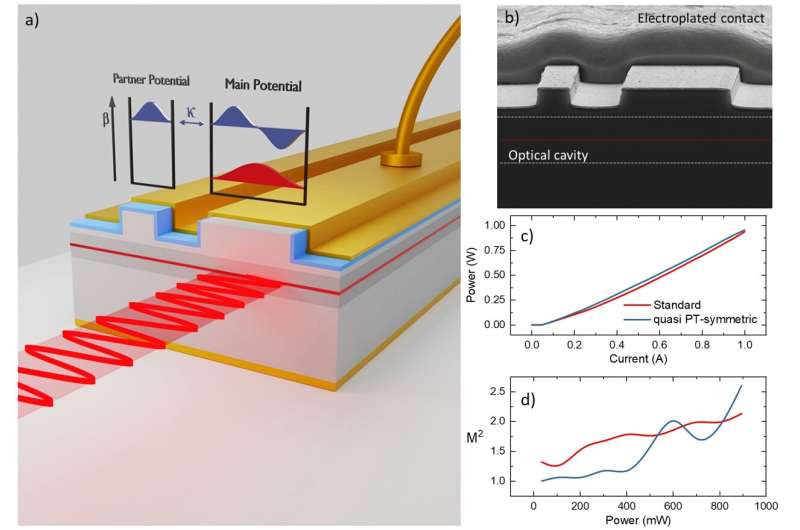This article has been reviewed according to Science X's editorial process and policies. Editors have highlighted the following attributes while ensuring the content's credibility:
fact-checked
peer-reviewed publication
trusted source
proofread
Researchers develop new electrically pumped edge-emitting laser chip with unprecedented performance

In a new study published in Light: Science & Applications , a team of scientists led by Asst. Prof. Abdullah Demir from UNAM-Institute of Materials Science and Nanotechnology, Bilkent University, has successfully developed a novel electrically pumped edge-emitting laser chip with unprecedented performance. This large-area quasi PT-symmetric laser has single-mode output power levels of 400 mW while maintaining beam quality comparable to narrow waveguide laser devices, and operates at room temperature without cooling.
Semiconductor lasers are ubiquitous in modern technology, but creating novel device architectures remains a challenge due to competing optimization goals. One of the major hurdles is that increasing the width of the laser waveguide can lead to degraded beam quality due to the emergence of higher-order modes. Existing techniques to overcome this obstacle may induce losses on the fundamental mode, demanding alternative strategies.
The research team's device consists of two coupled waveguides, with the partner potential supporting only one mode engineered to have the same propagation constant as the second-order mode of the main waveguide. This allows for selective pumping of the fundamental mode via current injection into the main waveguide, which enables lasing in the single-mode regime. The team verified the electrical and optical characteristics of the device using standard measurements.
A novel configuration of large-area semiconductor lasers is demonstrated to achieve high power emission and high beam quality. This is accomplished by implementing a quasi PT-symmetry between the second-order mode of a two-mode laser cavity and that of a single-mode auxiliary partner cavity. The new approach allows for a selective pump of the fundamental optical mode leading to lasing in the single-mode regime. The laser is constructed using a material platform and fabrication process that adhere to industrial standards for semiconductor lasers.
Non-Hermitian photonics has recently emerged as a promising avenue to enhance laser performance. Among these concepts, parity-time (PT) symmetry has shown potential to suppress higher-order modes and enable single-mode operation. The interplay between non-Hermitian effects and other symmetry concepts has also been investigated to develop new designs. However, it is uncertain if these concepts can be extended to realistic devices due to thermal effects and resonant frequency shifts induced by higher carrier concentrations and optical powers.
More information: Enes Şeker et al, Single-mode quasi PT-symmetric laser with high power emission, Light: Science & Applications (2023). DOI: 10.1038/s41377-023-01175-6
Journal information: Light: Science & Applications
Provided by Chinese Academy of Sciences





















